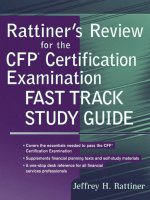John wiley sons chromatography modern derivatization methods for separation sciences 1999
Bạn đang xem bản rút gọn của tài liệu. Xem và tải ngay bản đầy đủ của tài liệu tại đây (6.34 MB, 588 trang )
Document
/>
Página 1 de 1
30/09/2003
Document
Página 1 de 1
Page iii
Modern Derivatization Methods for Separation Sciences
Edited by
Toshimasa Toyo'oka
School of Pharmaceutical Sciences, University of Shizuoka, Japan
/>
30/09/2003
Document
Página 1 de 2
Page iv
Copyright (c) 1999 John Wiley & Sons Ltd,
Baffins Lane, Chichester,
West Sussex PO19 IUD, England
National 01243 779777
International (+44) 1243 779777
e-mail (for orders and customer service enquiries):
Visit our Home Page on http://www/wiley.co.uk
or
All Rights Reserved. No part of this publication may be reproduced, stored in a retrieval system, or
transmitted, in any form or by any means, electronic, mechanical, photocopying, recording, scanning or
otherwise, except under the terms of the Copyright Designs and Patents Act 1988 or under the terms of
a licence issued by the Copyright Licensing Agency, 90 Tottenham Court Road, London WIP 9HE,
UK, without the permission in writing of the Publisher
Other Wiley Editorial Offices
John Wiley & Sons, Inc., 605 Third Avenue,
New York, NY 10158-0012, USA
WILEY-VCH Verlag GmbH, Pappelallee 3,
D-69469 Weinheim, Germany
Jacaranda Wiley Ltd, 33 Park Road, Milton,
Queensland 4064, Australia
John Wiley & Sons (Asia) Pte Ltd, Clementi Loop #02-01,
Jin Xing Distripark, Singapore 129809
John Wiley & Sons (Canada) Ltd, 22 Worcester Road,
Rexdale, Ontario M9W IL1, Canada
Library of Congress Cataloging-in-Publication Data
Modern derivatization methods for separation sciences/edited by Toshimasa Toyo'oka.
p. cm.
Includes bibliographical references and index.
ISBN 0-471-98364-0 (alk. paper)
1. Chromatographic analysis-Methodology. 2. Derivatization.
I. Toyo'oka, Toshimasa.
QD79.C4M63
1999
98-27197
543'.089-dc21
CIP
British Library Cataloging in Publication Data
A catalogue record for this book is available from the British Library
ISBN 0 471 98364 0
/>
30/09/2003
Document
Página 2 de 2
Typeset in 10/12pt Times by Laser Words, Madras, India
Printed and bound in Great Britain by Bookcraft (Bath) Ltd
This book is printed on acid-free paper responsibly manufactured from sustainable forestry, in which at
least two trees are planted for each one used for paper production
/>
30/09/2003
Document
Página 1 de 2
Page v
Contents
List of Contributors
Preface
xi
xiii
1. Pre-treatment for Real Sample Analysis and Choice of Suitable Reagent
1
1.1. Derivatization for Drugs
Akihiko Nakagawa, and Yukinori Kawahara
1
1.1.1. Introduction
2
1.1.2. Application of Derivatization of Drugs
2
1.1.2.1. Determination of Pravastatin Sodium in Plasma by
HPLC with Laser-induced Fluorescence Detection after
Immobilized Antibody Extraction
2
1.1.2.2. Enantiospecific Determination of Ibuprofen in Rat
Plasma Using Chiral Fluorescence Derivatization Reagent, (-)-2[4-(1-aminoethyl)phenyl]6-methoxybenzoxazole
4
1.1.2.4. Specific Fluorogenic Derivatization of Ivermectin Using
Non-fluorescent Reagents
6
1.1.2.4. Other Methods
8
1.1.3. Conclusion
10
References
1.2. Derivatization for Agrochemicals
Hiroyuki Nakazawa and Koichi Saito
1.2.1. Introduction
13
13
1.2.1.1. Sample Preparation
14
1.2.1.2. Derivatization in Food Analysis
15
1.2.2. Analysis of Nutrients
16
/>
30/09/2003
Document
Página 2 de 2
1.2.2.1. Carbohydrates
16
1.2.2.2. Amino Acids and Peptides
17
1.2.2.3. Fatty Acids
22
1.2.2.4. Organic Acids
23
1.2.2.5. Vitamins
24
1.2.2.6. Minerals
26
/>
30/09/2003
Document
Página 1 de 2
Page vi
1.2.3. Analysis of Food Additives
27
1.2.3.1. Preservatives
27
1.2.3.2. Antioxidants
27
1.2.3.3. Sweeteners
28
1.2.3.4. Emulsifiers
28
1.2.3.5. Other Food Additives
29
1.2.4. Analysis of Veterinary Medicine
29
1.2.4.1. Sulfonamides
30
1.2.4.2. Antibiotics
30
1.2.4.3. Antiparasitic Agents
32
1.2.5. Analysis of Pesticides
34
1.2.6. Analysis of Natural Toxins
35
1.2.6.1. Mycotoxins
35
1.2.6.2. Marine Toxins
39
1.2.6.3. Plant Toxin
42
1.2.7. Analysis of Food Contaminants
42
1.2.7.1. Amines
42
1.2.7.2. Organotin
43
1.2.7.3. Hydroperoxides
45
1.2.7.4. Isocyanate Monomers
45
References
45
/>
30/09/2003
Document
Página 2 de 2
1.3. Derivatization for Environmental Contaminants
Kazuo Iwaki
51
1.3.1. Introduction
51
1.3.2. Environmental Samples
51
1.3.2.1. Gas Sample
51
1.3.2.2. Soil and Various Water Samples
53
1.3.3. Application
55
1.3.3.1. Aldehydes and Ketones in Air
55
1.3.3.2. Aliphatic Amines in Air
57
1.3.3.3. Residual Pesticides and Herbicides in Soil and Water
59
References
2. Reagent for UV-VIS Detection
Kiyoshi Zaitsu, Masaaki Kai and Kenji Hamase
62
63
2.1. Introduction
64
2.2. Label of Amines and Amino Acids (-NH2, NH)
65
2.2.1. Nitrobenzenes
65
2.2.1.1. 1-Fluoro-2,4-dinitrobenzene (FDNB, 2,4-dinitro-1fluorobenzene, Sanger Reagent)
65
2.2.1.2. 4-Fluoro-3-nitrotrifluoromethylbenzene (4-fluoro-3nitrobenzotrifluoride) (FNBT)
66
2.2.1.3. 2,4,6-Trinitrobenzene-1-sulfonic Acid (TNBS)
67
2.2.1.4. Na-(2,4-Dinitro-5-fluorophenyl)-L-alanine amide
(FDAA, 1-Fluoro-2,4-dinitrophenyl-5-L-alanine amide,
Marfey's Reagent)
67
/>
30/09/2003
Document
Página 1 de 3
Page vii
2.2.2. Acetic Anhydride
67
2.2.3. Isocyanates and Isothiocyanates
67
2.2.3.1. Isocyanates
67
2.2.3.2. Phenyl Isothiocyanate (PITC, Edman Reagent)
68
2.2.3.3. Butylisothiocyanate (BITC)
70
2.2.3.4. 4-N,N-Dimethylaminoazobenzene-4'-isothiocyanate
(DABITC)
70
2.2.4. 1,2-Naphthoquinone-4-sulfonate (NQS)
70
2.2.5. Acyl Chlorides
71
2.2.5.1. Benzoyl Chloride
71
2.2.5.2. Dansyl Chloride (DNS-C1)
72
2.2.5.3. 4-N,N-Dimethylaminoazobenzene-4'-sulfonyl Chloride
(DABS-C1, Dabsyl-Cl)
73
2.2.6. 9-Fluorenylmethyl Chloroformate (9Fluorenylmethoxycarbonyl Chloride, FMOC-CL, Fluorescence and
UV Detection)
73
2.2.7. Ninhydrin
74
2.2.8. Diethylethoxymethylenemalonate (DEMM)
75
2.2.9. 6-aminoquuinolyl-N-hydroxyuccinimidyl Carbamate (AQC)
76
2.2.10. Disuccinimido Carbonate (DSC)
76
2.2.11. Solid-phase Reagent with UV or VIS Light Absorbing
Moiety
76
2.2.11.1. Polymeric 3,5-Dinitrobenzoyl Tagged Derivatization
Reagent
2.2.11.2. Polymeric 6-Aminoquinoline (6-AQ) Tagged
77
78
30/09/2003
Document
Página 2 de 3
Derivatization Reagent
2.2.11.3. Polymeric Benzotriazole Activated Reagent
Containing FMOC Group
2.3. Label of Carboxyl (-COOH)
78
78
2.3.1. Alkyl Halides
78
2.3.2. Aromatic Amines
79
2.3.3. Hydrazines
81
2.3.4. Hydroxylamine
82
2.4. Label of Hydroxyl (-OH)
84
2.4.1. Acyl Halides
84
2.4.2. Acid Anhydrides
86
2.4.3. Isocyanates
87
2.4.4. Other Reagents
88
2.5. Label of Reducing Carbohydrate
89
2.5.1. Reductive Amination
89
2.5.2. l-Phenyl-3-methyl-5-pyrazolone
91
2.5.3. Post-column Derivatizing Reagent
92
2.6. Label of Thiol (-SH)
92
2.6.1. 2-Halopyridinium Salt
92
2.6.2. Disulfide Reagent
93
2.6.3. Other Reagents
94
2.7. Labelling of Other Compounds
2.7.1. l-(2-Pyridyl)-piperazine (PYP)
94
94
30/09/2003
Document
Página 3 de 3
2.7.2. Diethyldithiocarbamate (DDTC)
94
2.7.3. 9-Methylamino-methylanthracene (MAMA)
95
References
95
30/09/2003
Document
Página 1 de 3
Page viii
3. Reagent for FL Detection
Masatoshi Yamaguchi, and Junichi Ishida
99
Abbreviations
100
3.1. Introduction
102
3.2. Reagents for Amines and Amino Acids
103
3.2.1. General Amino Compounds
103
3.2.1.1. Primary Amines and Amino Acids
103
3.2.1.2. Primary and Secondary Amines and Amino Acids
106
3.2.2. Particular Amines and Amino Acids
116
3.2.2.1. Catecholamines
116
3.2.2.2. Tryptophan and Indolamines
117
3.2.2.3. 5-hydroxyindoleamines (Serotonin Related
Compounds)
117
3.2.2.4. Guanidino Compounds
119
3.2.3. Peptides
121
3.2.3.1. General Peptides
121
3.2.3.2. Arginine-containing Peptides
121
3.2.4. Fluorescence Derivatization for CE
121
3.3. Reagents for Organic Acids
121
3.3.1. Carboxylic Acids
121
3.3.1.1. Fatty Acids
129
3.3.1.2. Prostaglandins
130
3.3.1.3. Steroids
131
30/09/2003
Document
Página 2 de 3
3.3.1.4. Glucuronic Acid Conjugates
132
3.3.2. α-Keto Acids
133
3.3.3. Sialic Acids and Dehydroascorbic Acid
133
3.4. Reagents for Alcohols
135
3.5. Reagents for Phenols
139
3.6. Reagents for Thiols
141
3.7. Reagents for Aldehydes and Ketones
146
3.8. Reagents for Carbohydrates
150
3.9. Reagents for Dienes
152
3.10. Reagents for Nucleic Acid Related Compounds
153
References
158
4. Reagent for CL Detection
Naotaka Kuroda and Kenichiro Nakashima
167
4.1. Introduction
167
4.2. Label of Amines (-NH2, -NH)
171
4.3. Label of Carboxyl (-COOH)
176
4.4. Label of Hydroxyl (-OH) and Thiol (-SH)
178
4.5. Label of Other Functional Groups
179
4.6. Application
183
References
183
5. Reagents for Electrochemical Detection
Kenji Shimada, Tomokazu Matsue and Kazutake Shimada
5.1. Introduction
191
192
30/09/2003
Document
5.1.1. Amperometric Analysis in Flowing Streams
Página 3 de 3
192
30/09/2003
Document
Página 1 de 3
Page ix
5.1.2. Electrochemical Detectors
192
5.1.3. Electrode Material
193
5.1.4. Electrode Configuration
194
5.1.5. Mobile Phase
195
5.1.6. Chemical Derivatization
196
5.2. Labeling of Primary and Secondary Amines
198
5.2.1. o-phthalaldehyde
198
5.2.2. Naphthalene-2,3-dicarbaldehyde
199
5.2.3. Ferrocene
200
5.2.4. Isocyanate and Isothiocyanate
202
5.2.5. Salicylic Acid Chloride
203
5.2.6. 2,4-Dinitrofluorobenzene
204
5.2.7. 1,2-Diphenylethylenediamine
204
5.2.8. Bolton and Hunter Type Reagent
204
5.2.9. Others
205
5.3. Labeling of Carboxy Groups
205
5.4. Labeling of Hydroxy Groups
207
5.5. Labeling of Thiol Groups
208
5.6. Labeling of Other Functional Groups
208
5.7. Applications
211
References
213
/>
30/09/2003
Document
Página 2 de 3
6. Derivatization for Resolution of Chiral Compounds
Toshimasa Toyo'oka
6.1. Introduction
217
218
6.1.1. Fundamentals of Stereochemistry
218
6.1.2. Chirality and Biological Activity
220
6.1.3. Chirality Application as Single Isomers
222
6.2. Resolution of Racemates
223
6.2.1. Direct Resolution
223
6.2.2. Indirect Resolution
223
6.3. Reactions of Various Functional Groups
225
6.3.1. Amines
225
6.3.2. Carboxyls
226
6.3.3. Hydroxyls
227
6.3.4. Thiols and Others
227
6.4. Derivatization for LC Analysis
228
6.4.1. Label for Alcohols
228
6.4.2. Label for Carboxylic Acids
230
6.4.3. Label for Aldehydes and Ketones
231
6.4.4. Label for Other Functional Groups
233
6.5. Derivatization for LC Analysis
6.5.1. Label for UV-VIS Detection
233
235
6.5.1.1. Label for Primary and Secondary Amines
235
6.5.1.2. Label for Carboxylic Acids
240
/>
30/09/2003
Document
Página 3 de 3
6.5.1.3. Label for Alcohols
241
6.5.1.4. Label for Other Functional Groups
241
/>
30/09/2003
Document
Página 1 de 1
Page x
6.5.2. Label for Fluorescence (FL), Laser-Induced Fluorescence
(LIF) and Chemiluminescence (CL) Detection
243
6.5.2.1. Label for Primary and Secondary Amines Including
Amino Acids 249
249
6.5.2.2. Label for Carboxylic Acids
257
6.5.2.3. Label for Alcohols
262
6.5.2.4. Label for Aldehydes and Ketones
266
6.5.2.5. Label for Thiols
266
6.5.2.6. Label for Other Functional Groups
267
6.5.3. Derivatization for Electrochemical (EC) Detection
267
6.6. Derivatization for Capillary Electrophoresis (CE) Analysis
267
6.7. Conclusion and Further Perspective
284
References
284
Index
291
/>
30/09/2003
Document
Página 1 de 2
Page xi
Contributors
Kenji Hamase, Ph.D.,
Department of Analytical Chemistry,
Faculty of Pharmaceutical Sciences,
Kyushu University,
3-1-1 Maidashi, Higashi-ku,
Fukuoka 812-8582, Japan,
Phone: +81-92 642-6598,
FAX: +81-92 642-6601,
E-mail: kyushu-u.ac.jp
Junichi Ishida, Ph.D.,
Department of Analytical Chemistry,
Faculty of Pharmaceutical Sciences,
Fukuoka University, Nakakuma,
Johnan-ku, Fukuoka 814-0180, Japan,
Phone: +81-92-871-6631
Kazuo Iwaki, Ph.D.,
Deputy General Manager,
Chemical Analysis Department,
Ebara Research Co. Ltd.,
2-1 Honfujisawa 4-chome,
Fujisawa-shi Kanagawa 251-8502, Japan,
Phone: +81-466-83-8276,
Fax: +81-466-83-3160,
E-mail:
Prof. Masaaki Kai, Ph.D.,
Chemistry of Functional Molecules,
School of Pharmaceutical Sciences,
Nagasaki University,
1-14 Bunkyo-Machi,
Nagasaki 852-8521, Japan,
Phone: +81-95 847-1111,
Fax: +81-95 843-1742,
E-mail:
Yukinori Kawahara, Ph.D.,
Director of Analytical and Metabolic Research
Laboratories,
Sankyo Co. Ltd., Hiromachi 1-2-58,
Shinagawa-ku, Tokyo 140, Japan,
Phone: +81-3-3492-3131
Naotaka Kuroda, Ph.D.,
Department of Hygienic Chemistry,
/>
30/09/2003
Document
Página 2 de 2
School of Pharmaceutical Sciences,
Nagasaki University,
1-14 Bunkyo-Machi, Nagasaki 852, Japan,
Phone: +81-958-47-1111,
Fax: +81-958-48-4219,
E-mail:
/>
30/09/2003
Document
Página 1 de 2
Page xii
Prof. Tomokazu Matsue, Ph.D.,
Graduate School of Engineering,
Tohoku University,
Aramaki, Aoba, Sendai 980-77,Japan,
Phone:+81-22-217-7209,
Fax:+81-22-217-7293,
E-mail:
Akihiko Nakagawa, Ph.D.,
Analytical and Metabolic Research Laboratories,
Sankyo Co.Ltd.,Hiromachi1-2-58,Shinagawa-ku, Tokyo 140, Japan,
Phone: +81-3-3492-3131,
E-mail:
Prof. Kenichiro Nakashima, Ph.D.,
Department of Hygienic Chemistry,
School of Pharmaceutical Sciences,
Nagasaki University, 1-14 Bunkyo-machi,
Nagasaki 852, Japan,
Phone: +81-958-47-1111 (Ex. 2526),
Fax: +81-958-42-3549,
E-mail:
Prof. Hiroyuki Nakazawa, Ph.D.,
Department of Analytical Chemistry,
Hoshi University, 2-4-41 Ebara,
Shinagawa-ku, Tokyo 142, Japan,
Phone: +81-3-5498-5763,
Fax: +81-3-5498-5765,
E-mail:
Koichi Saito, Ph.D.,
Senior researcher,
Department of Food Chemistry,
Saitama Institute of Public Health,
639-1, Kamiokubo,
Urawa, Saitama 338, Japan,
Phone: +81-48-853-6121,
Fax: +81-48-840-1041,
E-mail:
Prof. Kazutake Shimada, Ph.D.,
Department of Analytical Chemistry,
Faculty of Pharmaceutical Sciences, Kanazawa University,
Takaramachi 3-1,Kanazawa920-0934,Japan,
Phone: +81-76-234-4459,
Fax: +81-76-234-4459,
E-mail:
Prof. Kenji Shimada, Ph.D.,
30/09/2003
Document
Página 2 de 2
Department of Analytical Chemistry,
Niigata College of Pharmacy,
5-13-2 Kamishinei-cho, Niigata 950-2081, Japan
Phone: +81-25-268-1172,
Fax: +81-25-268-1177,
E-mail:
Prof. Toshimasa Toyo'oka, Ph.D.,
Department of Analytical Chemistry,
School of Pharmaceutical Sciences,
University of Shizuoka,
52-1 Yada, Shizuoka 422-8526, Japan,
Phone: +81-54-264-5656,
Fax: +81-54-264-5593,
E-mail:
Prof. Masatoshi Yamaguchi, Ph.D.,
Department of Analytical Chemistry,
Faculty of Pharmaceutical Sciences,
Fukuoka University, Nakakuma,
Johnan-ku, Fukuoka 814-0180, Japan,
Phone:+81-92-871-6631(Ex.6618),
E-mail:
Prof. Kiyoshi Zaitsu, Ph.D.,
Department of Analytical Chemistry,
Faculty of Pharmaceutical Sciences,
Kyushu University, 3-1-1 Maidashi,
Higashi-ku, Fukuoka 812-8582, Japan,
Phone: +81-92 642-6596,
FAX: +81-92 642-6501,
E-mail: zaitsu@analysis. phar. kyushu-u.ac.jp
30/09/2003
Document
Página 1 de 1
Page xiii
Preface
Biologically active compounds are ubiquitous in our lives. They are used for medicines, agrochemicals
(e.g. pesticides and harbicides), food additives, biogenic amines and flavors. It is fairly difficult to
determine them with accuracy and precision, because they usually exist in munite amounts, especially
in real biological and environmental samples. The choice of a suitable method that provides good
reproducibility is essential to obtain correct results. Separation analysis represented by various
chromatography is recommended for the quantitation of analytes in complex matrices.
Derivatization was an important technique for analysis using gas chromatography in the early stages.
The main purpose of the derivatization was to add volatility to saccarides and amino acids. In this
derivatization, selectivity and sensitivity were not considered. However, derivatization is the essential
technique in separation sciences using thin-layer chromatography (TLC), liquid chromatography (LC)
and capillary electrophoresis (CE), as well as gas chromatography (GC). For analysis by highperformance liquid chromatography (HPLC), various reagents have been developed to increase
separability, selectivity and sensitivity. This is due to the development of various types of detection
instruments such as ultravioletvisible (UV-VIS), fluorescence (FL), chemiluminescence (CL) and
electrochemical (EC). The use of derivatization in separation sciences is mainly to improve the
chromatographic properties and detection sensitivity.
The major aim of this book is to provide an easyto-read overview of various derivatization methods that
are available for minute analyses of biological importance. Emphasis is placed on practical use, and the
characteristics (merits and demerits) of the various approachs are critically discussed. The derivatization
listed in this book is a reaction which produces covalent binding between the analyte and the reagent.
This book describes recent advances in chemical derivatization for the separation sciences mainly by
GC, LC and CE.
The first chapter presents a general introduction of the pre-treatment of real samples such as biological,
food and environmental. The pretreatment is the clean-up method for derivatization to obtain a trace
amount of analyte without contamination. This part is most important because the accuracy and
precision of the result obtained is dependent on the pre-treatment method, especially in trace analysis.
In Chapters 2 and 3, homogeneous reactions suitable for the derivatization of various functional groups
of trace analytes with UV-VIS and FL labels are described in detail. Preand post-column applications
and typical derivatization procedures are given for each functional group. Chapter 4 deals with the
chemiluminescence (CL) detection
30/09/2003
Document
Página 1 de 1
Page xiv
of fluorophores derived from the fluorogenic reaction and fluorescence labelling reaction. This is one of
the most sensitive detection methods, capable of detecting fmol-amol levels. However, this detection
system is not applicable to all fluorescent materials, a notable disadvantage. In Chapter 5, the theory of
electrochemical reactions and derivatization for eictrochemical detection are described, together with
some examples. Detection is based on a redox reaction of the electrodes and is suitable for compounds
easily oxidized and reduced with low potential. Finally, chiral resolution continues with the
derivatization for effective separation and high-sensitivity detection.
There are some excellent books on derivatization, but they do not address the specifics of the topic.
Each chapter includes sufficient references to the literature to serve as a valuable starting point for more
detailed investigations.
As shown in the bibliography, scientists in Japan are very active in these fields. The contributors and
the authors selected for this book are outstanding research chemists. This book should be useful to
many investigators in various fields, including clinical, pharmaceutical, biological and environmental.
The editor would like to express sincere thanks to the authors for their contributions, as well as to their
colleagues for providing stimulating discussions. Thanks are also due to the entire publishing staff at
John Wiley &
Sons for their continued support and contribution towards the completion of this book.
TOSHIMASA TOYO'OKA
SHIZUOKA, JAPAN
30/09/2003
Document
Página 1 de 1
Page 1
1—
Pre-treatment for Real Sample Analysis and Choice of Suitable Reagent
1.1—
Derivatization for Drugs
Akihiko Nakagawa, and Yukinori Kawahara
Analytical and Metabolic Research Laboratories, Sankyo Co.Ltd., Tokyo, Japan
1.1.1. Introduction
2
1.1.2. Application of Derivatization of Drugs
2
1.1.2.1. Determination of Pravastatin Sodium in Plasma by HPLC
with Laser-induced Fluorescence Detection after Immobilized
Antibody Extraction
2
1.1.2.2. Enantiospecific Determination of Ibuprofen in Rat
Plasma Using Chiral Fluorescence Derivatization Reagent, (-)-2[4-(1-aminoethyl)phenyl]-6-methoxybenzoxazole
4
1.1.2.3. Specific Fluorogenic Derivatization of Ivermectin Using
Non-fluorescent Reagents
6
1.1.2.4. Other Methods
8
1.1.3 Conclusion
References
10
11
Edited by Toshimasa Toyo'oka: Modern Derivatization Methods for Separation Sciences (c) 1999 John Wiley &
Sons Ltd.
/>
30/09/2003









